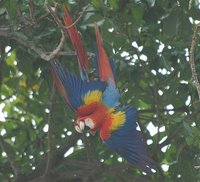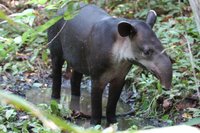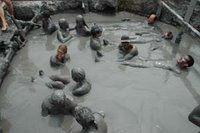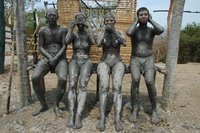The bus trip from the town of David, northern Panama, started at 6am. Three hours later and I crossed on foot into Costa Rica, at the town of Paso Canoas. Here I hopped onto a chicken bus which, almost 2 hours later, dropped me off at the sleepy little harbor town of Golfito -- right on the slopes of the Gulf of Dulce. From here it was a 45 minute boat ride to the tiny dirt-street village of Puerto Jiménez. Tired...eat, drink and sleep! Next morning started at 6am as I jumped on the back of the open mini truck -- collectivo -- for the two hour bumpy dirt road ride to Carate on the Pacific Coast. Carate is not much more than a store with sky-high prices. Here the fun started as I embarked on the 7 hour hike thru the jungle and on

the beach to Sirena Ranger Station -- in the heart of Corcovado National Park, on the Peninsule de Orso. Here I stayed in a basic cabin for 2 nights.
Corcovado National Park has been called "the most biologically intense place on Earth" by
National Geographic and without a doubt one of the most remote areas of Costa Rica
.This park is one of the most awesome natural preserves in the Americas. The mangroves, swamps and thick forest make Corcovado a botanist's dream. Animals to see -- Jaguars, pumas, tamanduás (giant anteaters), white-lipped peccaries, coaties, agoutis, tayras, tapirs, several species of monkeys (Capuchin Monkeys, Squirrel Monkeys, Spider Monkeys, and Howlers), emerald Jesus Christ lizards, iguanas, sloths, crocodiles, snakes, hundreds of green parrots and

scarlet macaws and many other rare animals inhabit the forest. I saw all the above except for the jaguar, puma, peccaries, and the still evasive sloth! Woke up in the mornings at 5am (for hiking) with the sounds of howler monkeys right next to the cabin. Outside the scarlet macaws breakfast on the green nuts. Corcovado has the highest concentration of scarlet macaws in Costa Rica with an estimated population of about 1,600.
Stories of the day:
1. Crawled up to 2 meters from a 6-feet crocodile before he jumped into the river
2. Saw tapirs twice....once during the night and another during daytime. The one I saw at night actually charged at me and you can guess what I did....got great pics!
3. Swam several times in the crystal clear streams while drinking the water.
Au Natural Costa Rica!
The return trip to the village of Puerto Jiménez felt easier!
Adios...as I am taking the 9-hour bus ride to the capital city - San Jose.








